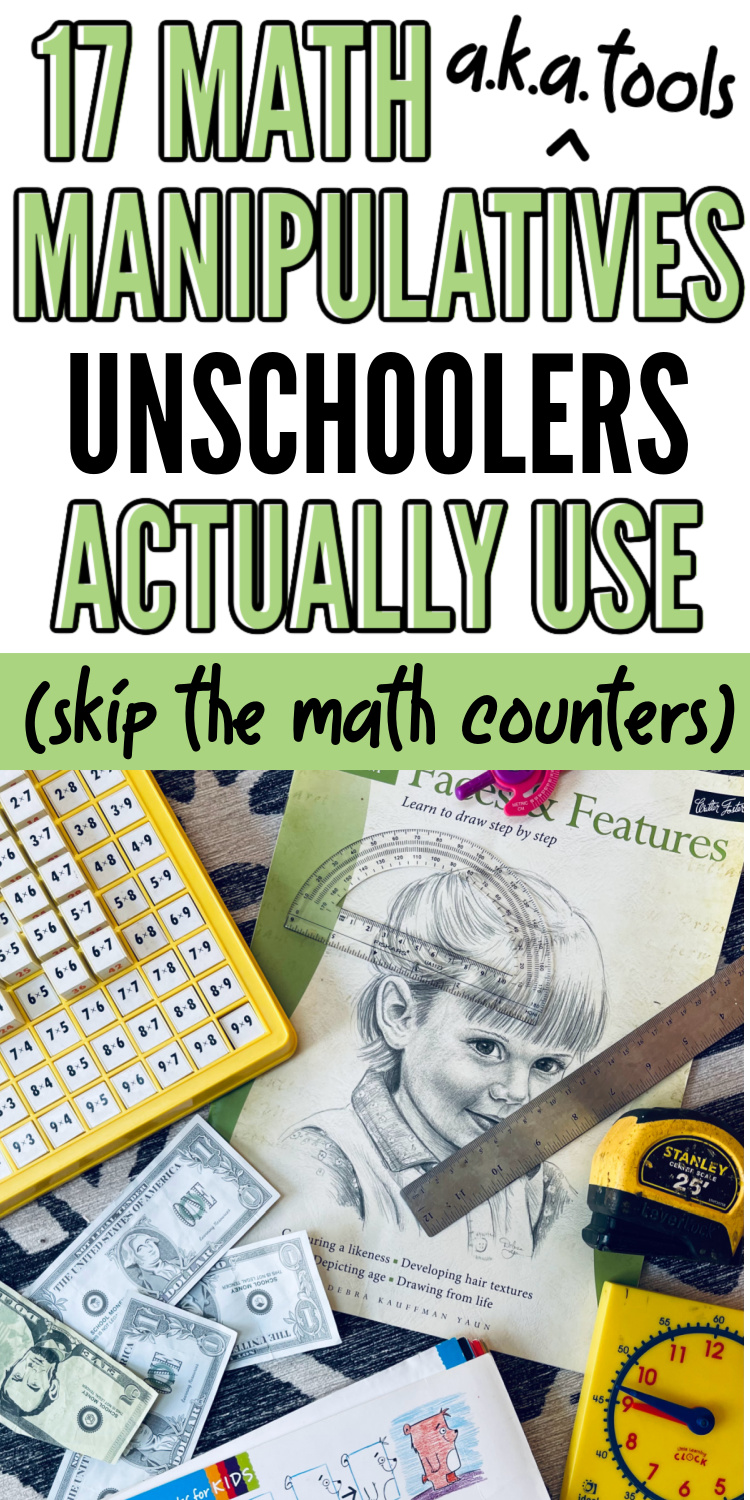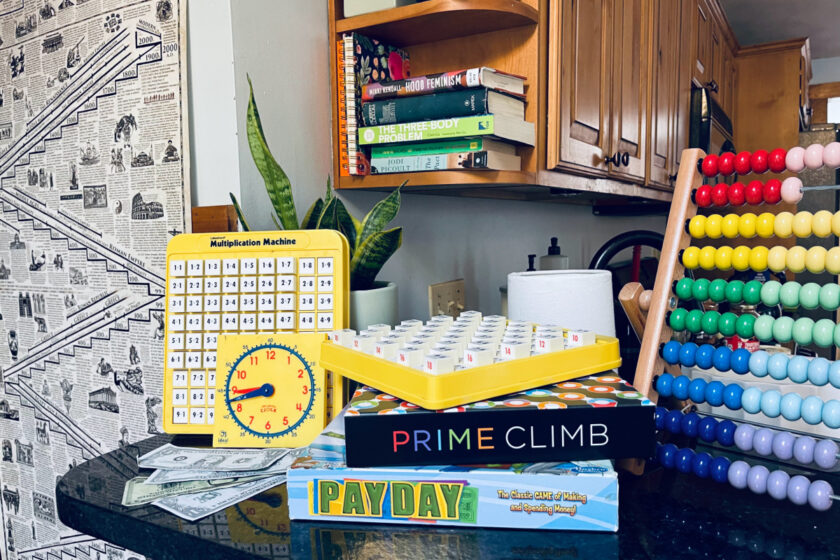Inside: A growing list of math manipulatives your unschooled kids might actually use. Add to your collection of math tools to strew or to support natural math learning, play and exploration.
Last week, my middle kiddo came to me and made a request that, had I been drinking a beverage (any beverage), would have caused me to spew it all over him.
“Do you have something I can use to measure the angle of a slope for the candy sorter I’m building?”
Now maybe that question wouldn’t floor a parent of a traditionally schooled child. That’s not me, so I don’t know.
But for this unschooling parent who still marvels that yes, kids will do math all the time without being forced to do math, it was pretty revolutionary.
I tried not to look too eager and directed him to my civil engineer husband, who upon being asked the same question reverently closed his eyes and held his hands over his heart.
It was a moment he thought would never come: a child organically asking about angles and slopes and all kinds of more advanced mathy things.
After his moment of silent gratitude, he promptly added a protractor and compass kit to the Amazon cart.
It was the one math tool we didn’t already have, and it got me thinking about all the other math “manipulatives” we’ve added to our unschooling household over the years that have been worth buying – and keeping year after year.
(And no, counters are NOT one of them.)
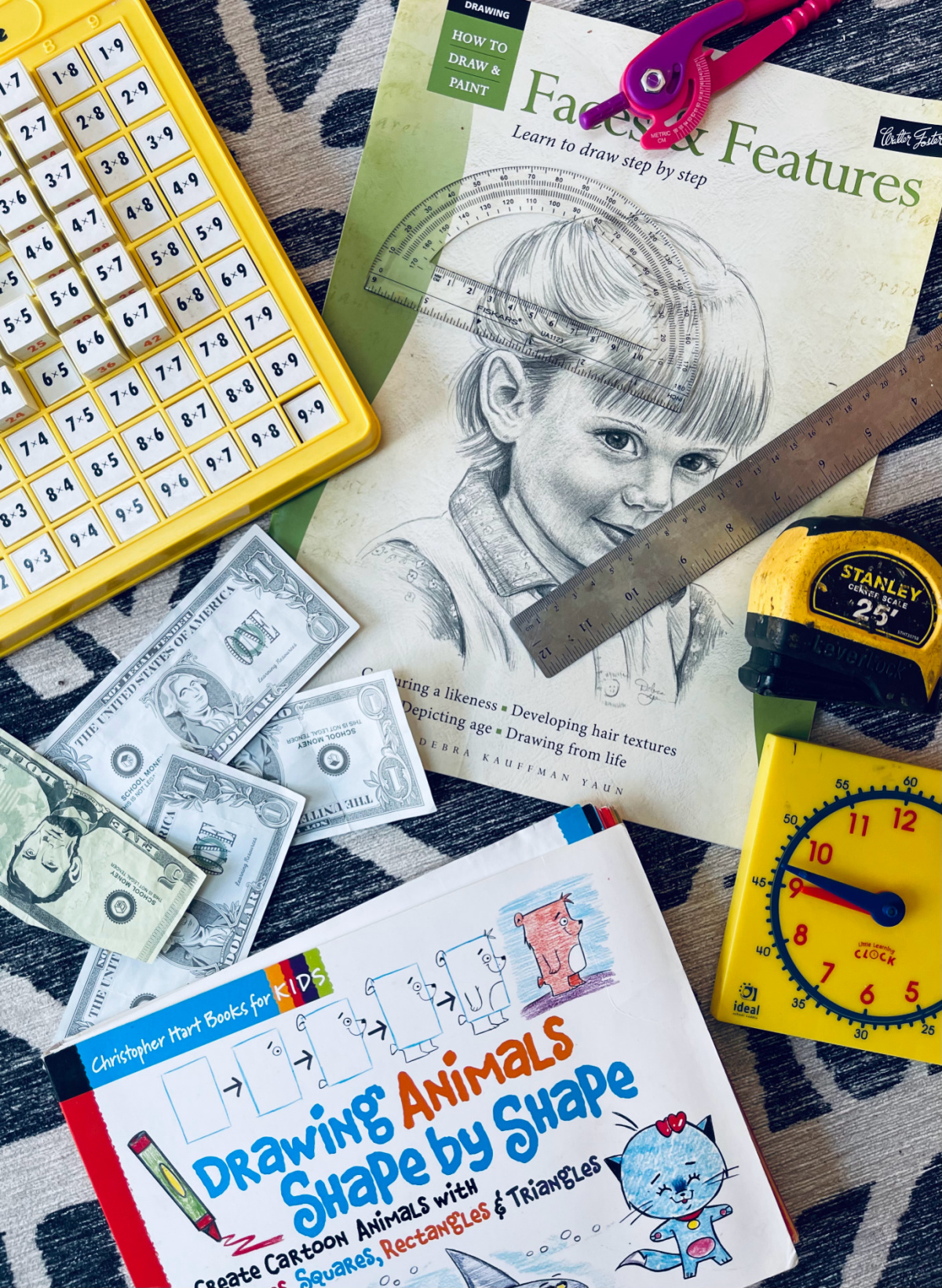
Fun Math Tools for Unschooling Families (to Strew or Support Math Exploration)
This post probably contains affiliate links, which means I may earn a commission if you make a purchase through those links. As an Amazon Associate, I earn from qualifying purchases. You can find our full disclosure HERE.
When we first started homeschooling officially (we “unofficially” homeschooled with a hybrid school when my oldest was 4-years-old for a year), I purchased a big ol’ boxed curriculum set.
I chose Saxon math *shudder*, which is probably, in retrospect, a good thing because it quickly led to us ditching curriculum and starting down the road to unschooling.
The kindergarten Saxon math curriculum came with these colorful little plastic bears they called “counters”. That’s when I first heard the term “math manipulative”.
I was super confused.
Couldn’t my kid count pennies, gummy bears, Duplo blocks – or just about ANYTHING ELSE we had lying around the house?!
As ridiculous as those counters were (to me, at least), we did add a variety of other actually useful “math manipulatives” over the years to our relaxed homeschooling – and eventually unschooling – home.
Here are the math manipulatives my kids use all the time. Yours might like them, too.
You Might Also Like: The Pros and Cons of Unschooling – Some Brutal Honesty
1. Calculator
Kids love playing with calculators!
Beyond basic functions like addition and multiplication, calculators can start conversations about exponents, negative numbers and so much more.
Yes, we have calculators on our phones and ipads. But we did buy a simple solar-powered calculator at the dollar store that also gets used.
2. Abacus
I admit, I bought this at first because it was just.so.pretty. IKEA got me.
But it turns out kids love to make fun patterns, and sometimes they like to count the beads.
And did I mention it’s so pretty?
3. Learning Resources “Machines”
When my kids were younger, they enjoyed these far more for the push down buttons than the math problems. But as they got older, they grew curious about the numbers on the tops and sides of the buttons.
The multiplication tool is also handy for quick multiplication facts when playing math games like Prime Climb.
(We do also have THIS colorful “count to 100” pop-it toy that my 5-year-old loves!)
4. LEGO (or Other Blocks)
This might not be an obvious math manipulative, but LEGO is hands-on math at its finest.
Spatial awareness, counting, problem-solving, sorting and more! See more benefits of LEGO for kids HERE.
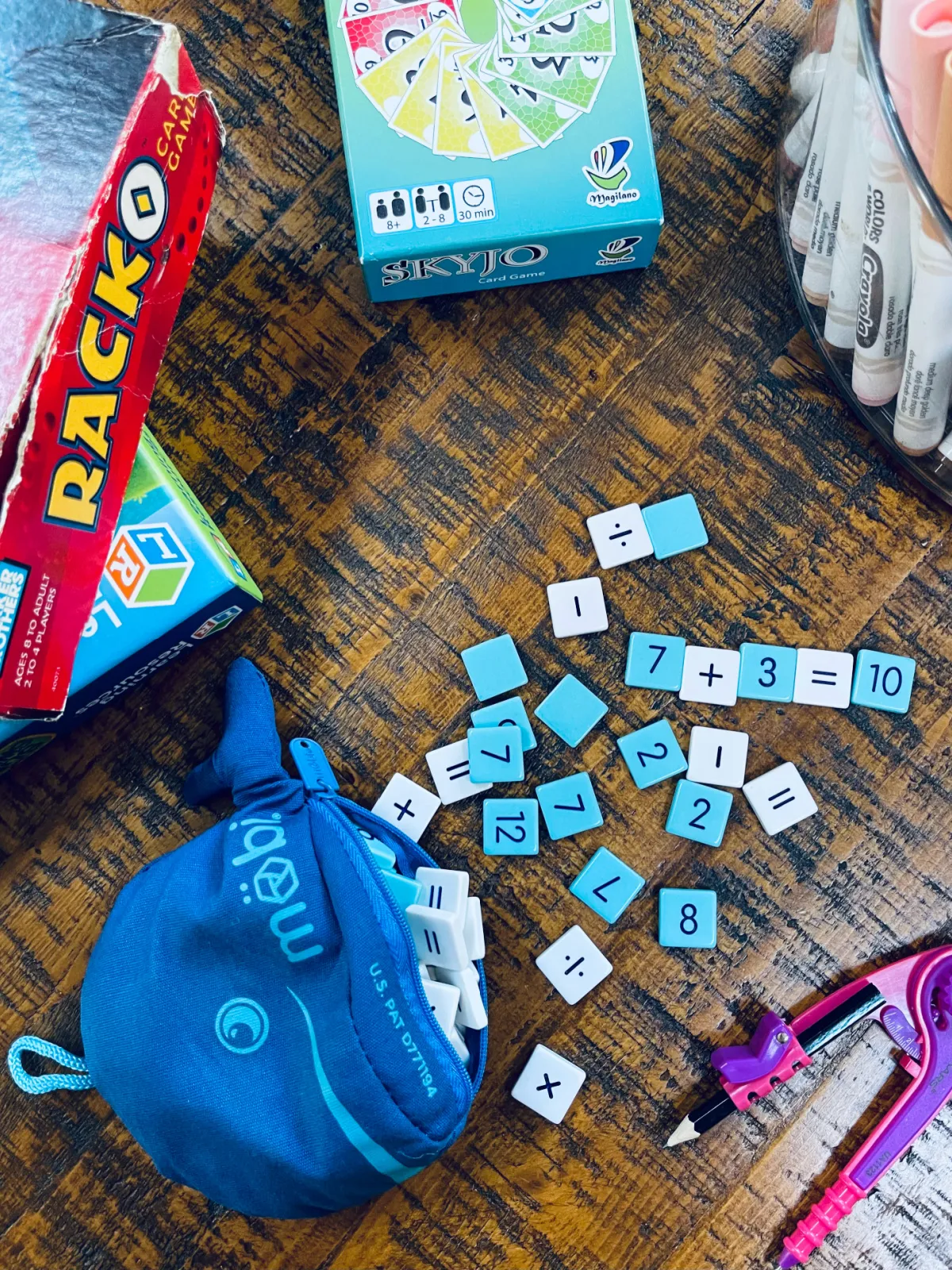
5. Mobitiles
Think of Mobitiles as the Scrabble of math. We use them for strewing – not the actual game.
My only criticism (and my 5-year-old’s) is that they did not include “0” tiles.
6. Graph Paper
Graph paper has so many fun uses.
Your kids will come up with all kinds of creative ways to use it if you keep some on hand.
7. Protractor
My kids are already pretty familiar with angles. If you think about it, we use them in everyday speech a lot!
“He did a 180. He did a 360.”
Keep a protractor on hand for when kids ask about angles, and/or set it out to see if it prompts questions or exploration.
8. Compass (Not the Navigation Kind…Although That Would Be Fun, Too!)
I honestly forgot these existed until one came with the protractor in THIS set! Use these to make perfect circles – any size.
These can be a little finicky for the younger set, so offer to step in when they get frustrated.
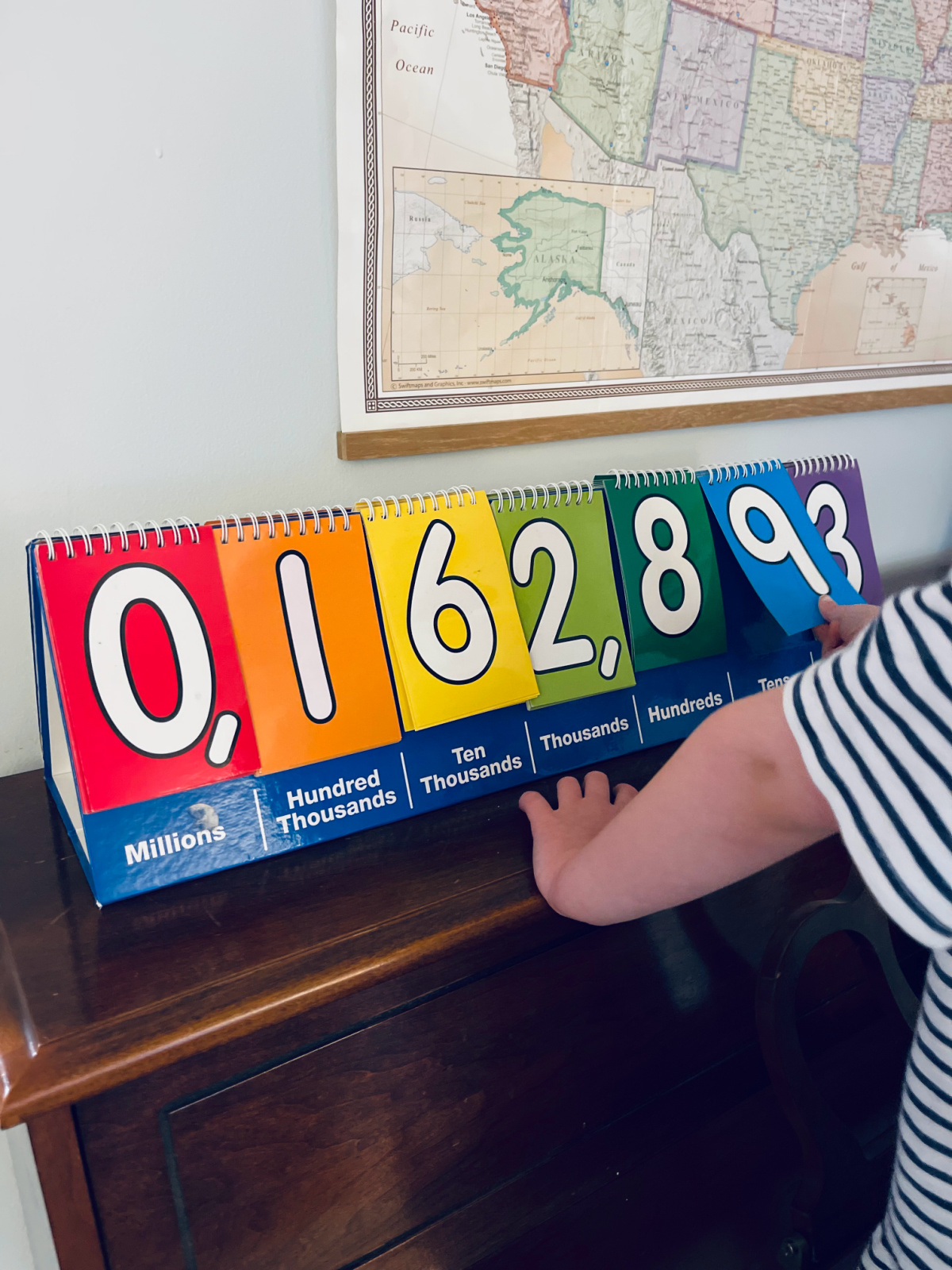
9. Place Value Chart
My mom gave us a place value chart like THIS one years ago. The teacher in her just couldn’t resist!
I was skeptical it would prove useful, but it was pretty, so I kept it (can you sense a theme?).
Turns out, my kids adored flipping the numbers and having me read the resulting number. Fantastic organic practice for hearing numbers read out loud and seeing place value names in print.
10. Play Money (or Real Money)
In my opinion, play money is a must for parenting, let alone homeschooling.
But you don’t need to pay for play money. Simply buy some math games like Money Bags or Monopoly.
If you go with Monopoly, you can keep a jar of real coins for your kids to play with. Or Money Bags has fake coins (and it’s a great game for learning about money!).
11. Greenlight Cards
All of our kids except the littlest have Greenlight debit cards and accounts.
It makes paying them for jobs ridiculously easy, and they can pay for their own online purchases using their debit cards.
It costs $5 a month, but I think it’s worth every penny.
(We also have an Acorns account for two of our kids to invest in index funds in the stock market.)
Related: 11 Money Lessons Desperately Kids Need That Schools Don’t Teach
12. Measuring Cups/Spoons
You probably have these in your kitchen already, but these are a great way to learn and practice basic fractions.
Two of my kids enjoy cooking, and another two enjoy “experiment baking” (no recipes allowed).
13. A Measuring Tape
Kids love to measure – themselves mostly, but also rooms, furniture, and more!
14. Ruler
Rules are great for smaller measurement projects. We have a wooden one and a metal one.
15. Hand-Held Clock
All of my kids enjoyed playing with this little clock (similar) when they were small.
Also, just having regular clocks up on the walls has a similar effect. Kids are curious! They’ll ask how to tell time without you ever prompting them.
(Bonus points if you have a Roman numeral clock.)
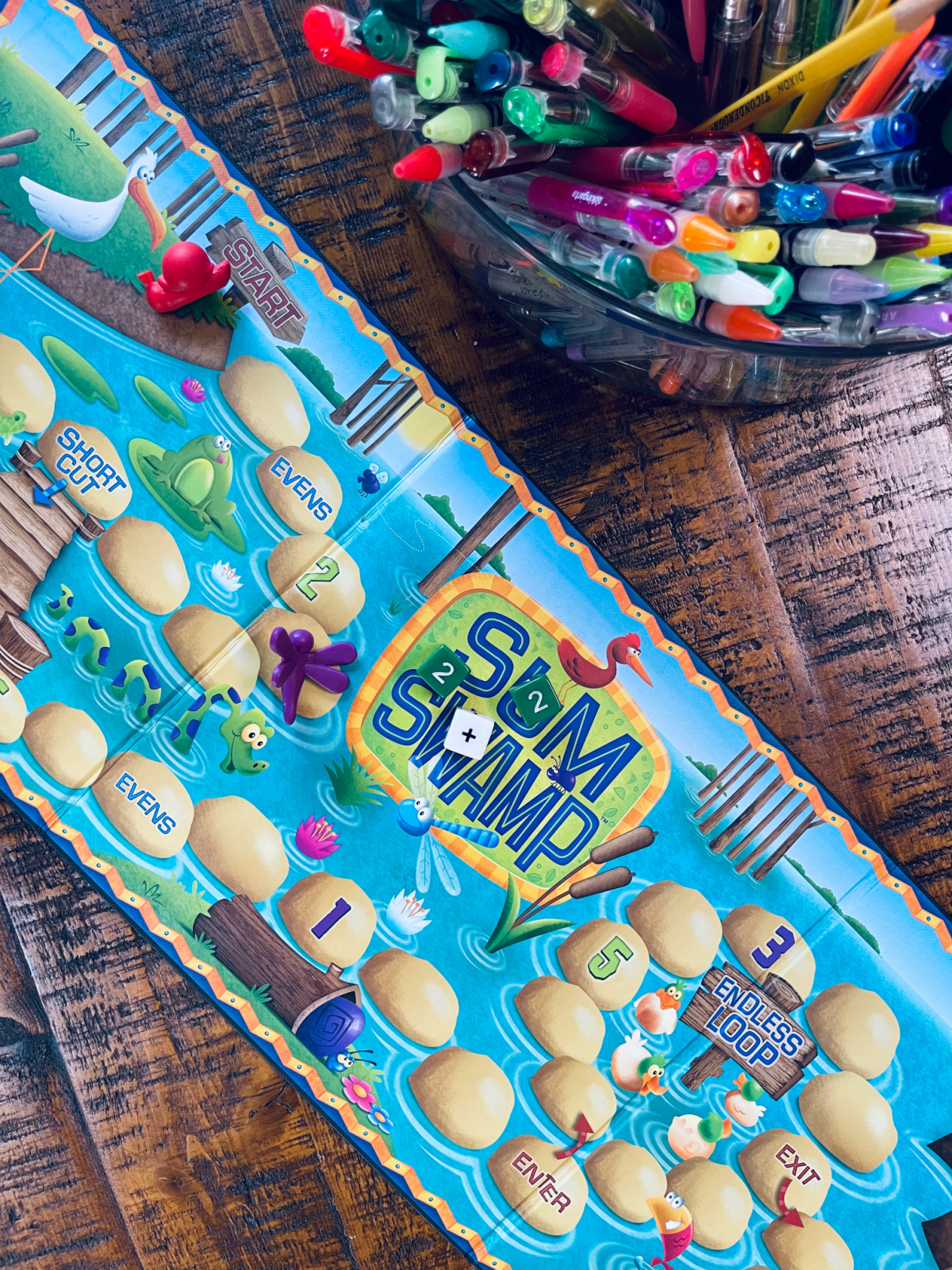
16. Math Board Games & Card Games
This is one of my favorite ways to encourage math play and exploration! Especially for some of my more math reluctant kiddos.
We have an entire collection, and I am working on updating my math board games blog post with our current favorites and deleting the duds.
(Because some math games for kids created by adults are most definitely duds).
17. Drawing Books
Drawing involves so much geometry! Shapes, spatial awareness, proportions.
I keep a cartoon drawing book and a more realistic one on hand for when they’re interested.
18. Video Games & Apps
While not technically math manipulatives, app-based games like Hay Day or Sim City or video games like Minecraft have spurred so much math use and math play!
So if you’re on the fence about video games and apps, they really are fantastic learning tools.
Related: The Case for Unlimited Screen Time (from a Recovering Control Freak)
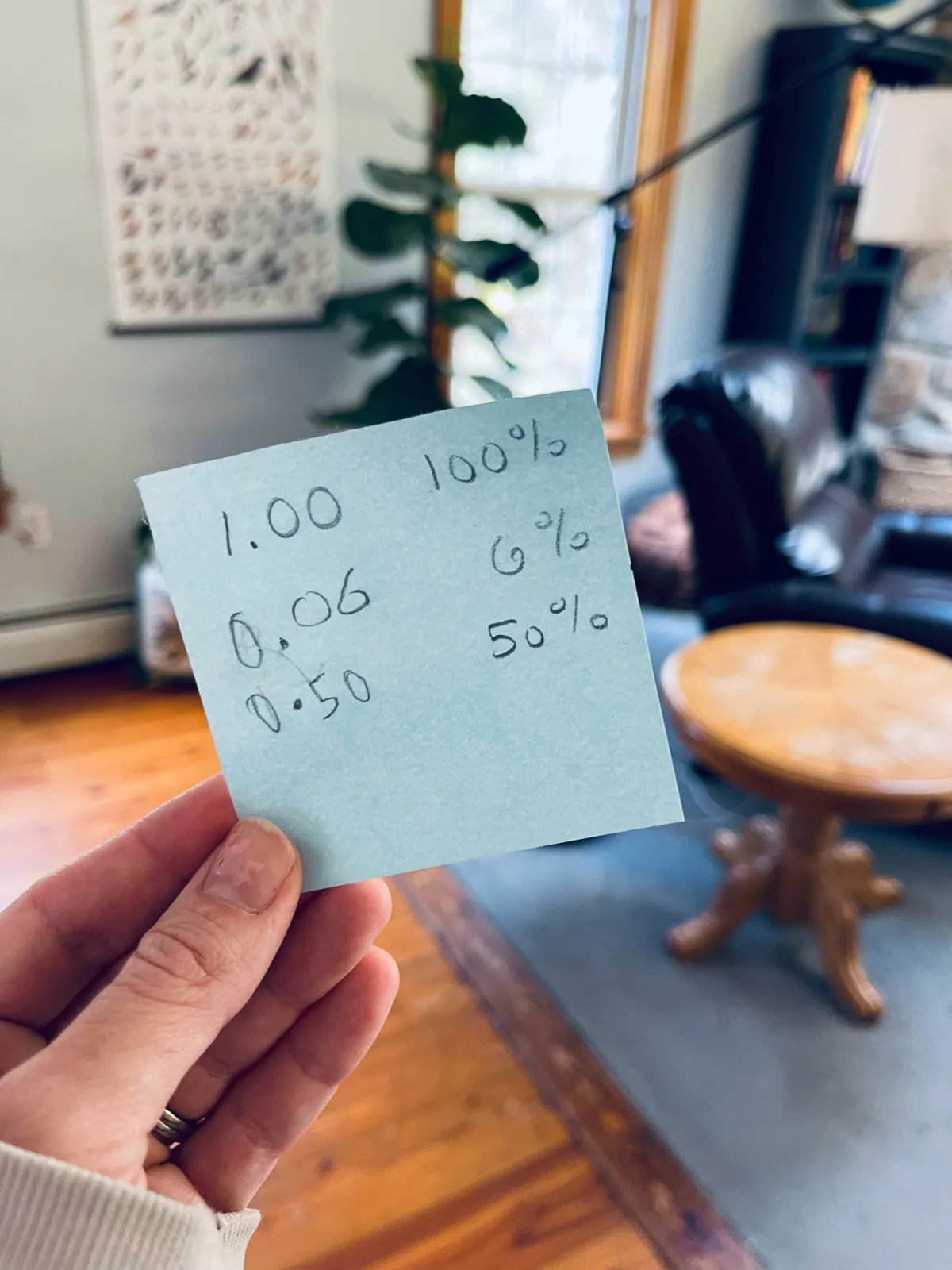
Kids Will Learn Math – With or Without Math Manipulatives
Many of the items on this list are common household items that you probably already have.
You don’t even technically need any of the items on this list for your kids to learn math. Pencils, paper, whiteboards, post-it notes – they’ll use whatever you have on hand.
That picture above? We used a post-it to practice converting percentages to decimals so my son could calculate tax on the computer keyboard he wanted to buy.
No calculator. Not even paper. A post-it note.
Kids will naturally play with math and numbers, just like they naturally play with words and language. They play with math from the time they are tiny, right up into the teenage years.
Make time and space for lots of play, be there to support them when they need it, and trust the process!
Read Next: 30 Delightful Math Picture Books My Kids Loved
Are there any math manipulatives that aren’t on this list that your unschooled kids enjoy using? Share in the comments!
